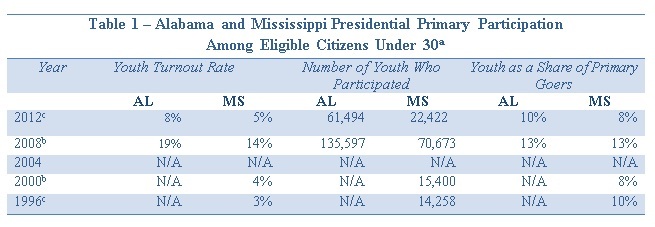Youth Turnout in Alabama 8%, Mississippi 5%
Santorum wins Youth Vote in Both States
MEDFORD/SOMERVILLE, Mass. – Eight percent of eligible voters under the age of 30 in Alabama and five percent in Mississippi participated in yesterday’s primaries, according to exclusive preliminary analysis by the Center for Information & Research on Civic Learning & Engagement (CIRCLE).
Former Sen. Rick Santorum was the overwhelming choice of young Republican voters in Alabama and Mississippi with 41% and 45% of the under-30 vote, respectively. In Alabama, Gingrich followed with 28%, while former Gov. Mitt Romney only gained 16% of youth support. In Mississippi, Romney snatched a close second-place finish with 24% of youth vote, while former Speaker of the House Newt Gingrich won 22%. Rep. Ron Paul finished with 12% youth support in Alabama and 9% in Mississippi. (See Table 2.)
The difference in youth turnout in Mississippi between 2012 (5%) and 1996 (3%) is within a margin of error. While no two primary years are the same, we compare the 2012 caucus to the 1996, since in both cases only one party had a competitive Republican primary race. No youth turnout information is available from the 1996 Alabama primary.
“Santorum performed poorly among young people in the early caucuses and primaries, as he did in his last Pennsylvania Senate race,” said CIRCLE director Peter Levine. “But he has improved his showing since Michigan, probably on the strength of socially conservative youth.”
Because of a lack of available data, the CIRCLE turnout estimates do not include young people who participated in yesterday’s Democratic primaries.
Youth turnout rate and number of youth votes are based on CIRCLE analysis of publicly available information (see Sources below).
a Mississippi allows 17-year-olds who will turn 18 by the General Election to vote in the primary. In Alabama, voters need to be 18 or older to vote in the primary.
b Combines the Democratic and Republican figures. For separate results by party in Mississippi and Alabama, see Table c 2012 and 1996 statistics only include the Republican Primary. In these years, there was/is no Democratic Primary, because there was an incumbent president from the Democratic Party that took the nomination.
Sources: The share of Primary participants is obtained from the 2012 and 2008 AL/MS exit poll conducted by Edison Research, and the 2000 and 1996 AL/MS exit poll conducted by Voter News Services. The numbers of votes cast are obtained from the NYTimes.com (as of 5:30 a.m. ET, 3/14/2012). The numbers of votes cast in the past election years were obtained from various sources including the Washington Post archives (1996), Federal Election Commission (2000 and 2004), and CNN.com (2008). Estimated voter turnout is obtained by taking the estimated number of votes cast by young people and dividing it by the estimated population of the 18- to 29-year-old citizens from the Current Population Survey (1995-2011). See p. 3 for definitions.
Comparisons to past years must be made with caution, because turnout is affected by the date of the primaries and by the nature of the Democratic and Republican presidential campaigns, which are different in every cycle. For example, in 2008 both the Republicans and Democrats held primaries, but in 2012 only the Republicans held a competitive primary. Table 3 provides estimates of youth participation in the Mississippi and Alabama primaries by party and year. CIRCLE has also calculated cumulative youth support for 2012 Republican candidates compared to cumulative youth participation in 2008. This can be found here.
Definitions
Youth: For the purpose of this press release and estimation of youth participation in the Michigan and Arizona Primaries, we define “youth” as citizens who were eligible to vote on March 6, 2012, as permitted by state election law.
Number of youth who participated: An estimate of how many youth participated in caucuses or primaries.
Youth share: An estimate of the number of young people who participated in the primary as a percentage of the number of all people who participated.
Youth turnout rate: An estimate of the number of young people who cast ballots as a percentage of the total number of young people who were eligible to participate on February 28, 2012.
The youth turnout rate is the best indicator of how young Americans are engaging in the political process. The other statistics—the sheer number of youth participants and the youth share of the electorate—can change because of factors unrelated to youth engagement.
To sign-up to receive copies of CIRCLE’s cutting-edge research on young Americans and next-day voter turnout estimates for the 2012 elections, please email amy@lunamediagroup.com.
Click here to obtain more extensive information about Mississippi‘s young voters and historical voting trends, and click here for Alabama.









